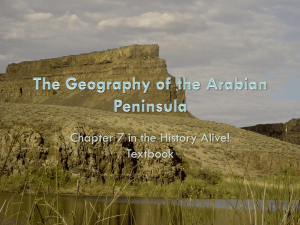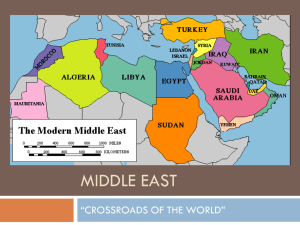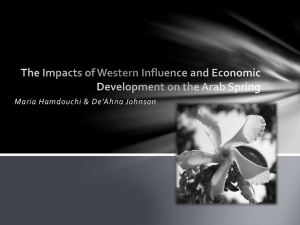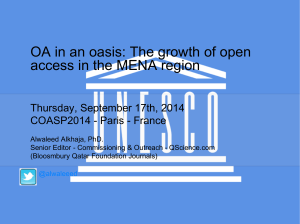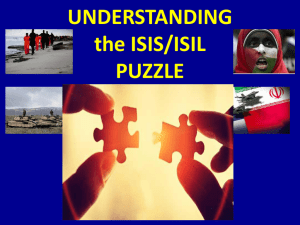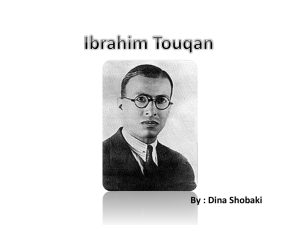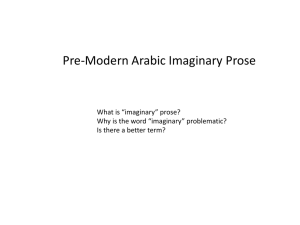File
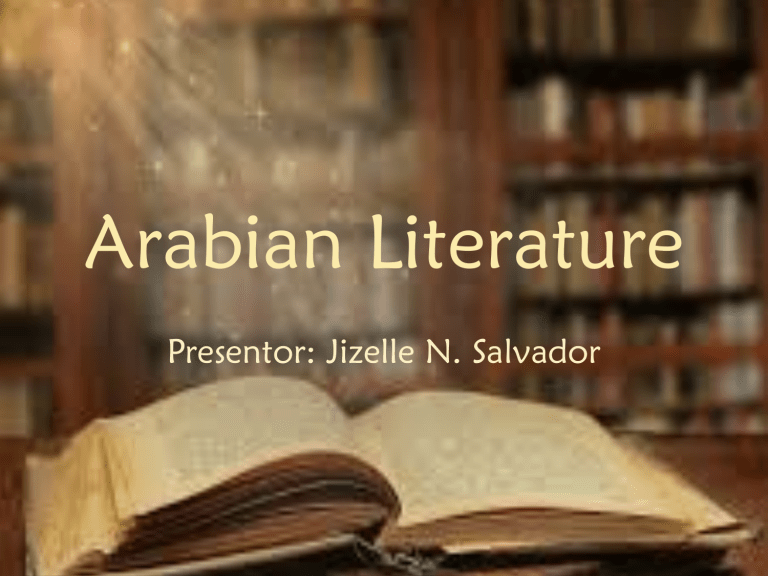
Arabian Literature
Presentor: Jizelle N. Salvador
Arabia (Arabian Peninsula)
• Western Asia situated north-east of Africa
• Bordered by the Red Sea to the west, the Persian Gulf to the northeast, the Levant to the north and the Indian
Ocean to the southeast.
• Extend to different regions such us Lebanon , Syria , Yemen , Oman , Qatar , B ahrain , Kuwait , Iraq , Saudi Arabia , Jordan , the eastern Sinai and the United Arab
Emirates .
A Passion for Form
A Passion for Form
The Arabia area is known for its passion in creativity. Artists, designers and craftsmen put their stamp on buildings, objects and a communal spirit that gives energy.
Arabs
• Also known as Arab people
• They primarily inhabit Western Asia , North
Africa , parts of the Horn of Africa , and other areas in the Arab world . Arab ethnic groups which inhabit or are adjacent to the Arabian plate includes
Female Male
Government
• Arabia was an absolute monarchy until
1992 at which time the Saud royal family introduced the country's first constitution.
• The legal system is based on the Sharia Law
(Islamic law).
History
• The history of the Arabian Peninsula goes back to the beginnings of human habitation in
Arabia up to 20,000 years ago.
• The region has twice in world history had a global impact.
• The first was in the 7th century when it became the cradle of Islam . The second was from the mid-20th century when the discovery of vast oil deposits propelled it into a key economic and geo-political role.
Historical Period
Pre-Islamic Arabia
• There is evidence that human habitation in the Arabian Peninsula dates back to about 10,000 to 20,000 years ago. However, the harsh climate historically prevented much settlement. In pre-Islamic Saudi
Arabia, apart from a small number of urban trading settlements, such as Mecca and Medina , located in the Hejaz in the west of the peninsula, most of what was to become Saudi Arabia was populated by nomadic tribal societies or uninhabitable desert.
However, archaeology has revealed the existence of civilizations in pre-Islamic Arabia (such as Thamud ).
• The Arabian peninsula has long been accepted as the original
Urheimat
of the Semitic languages by a majority of scholars.
The Rise of Islam
• Age of the Caliphs
Expansion under Muhammad , (brown)
Expansion during Rashidun or "rightly guided" Caliphate ,(orange)
Expansion during the Umayyad or successors Caliphate ,(yellow)
• The seventh century saw the introduction of Islam in the
Arabian Peninsula. The Islamic prophet Muhammad , was born in Mecca in about 570 and first began preaching in the city in 610, but migrated to Medina in 622. From there he and his companions united the tribes of
Arabia under the banner of Islam and created a single
Arab Muslim religious polity in the Arabian peninsula .
• He established a new unified polity in the Arabian peninsula which under the subsequent Rashidun and Umayyad Caliphates saw a century of rapid expansion of Arab power well beyond the Arabian peninsula in the form of a vast Muslim Arab Empire with an area of influence that stretched from the northwest Indian subcontinent , across Central Asia , the Middle East, North
Africa, southern Italy, and the Iberian Peninsula , to the Pyrenees .
• Following Muhammad's death in 632,
• the Ridda wars , or "Wars of Apostasy".
• Abu Bakr became leader
Byzantine Empire
• followed by Uthman ibn al-Affan
• and Ali ibn Abi Talib
the Persian Empire ,
• . The period of these first four caliphs is known as r ā shid ū n (R.A) al-khulaf ā
' ar-
The Middle Ages
• Despite its spiritual importance, in political terms
Arabia soon became a peripheral region of the Islamic world , in which the most important medieval Islamic states were based at various times in such far away cities as Damascus , Baghdad , and Cairo .
Modern history
• The provincial Ottoman Army for Arabia (Arabistan
Ordusu) was headquartered in Syria, which included
Lebanon, Palestine, and the Transjordan region. It was put in charge of Syria, Cilicia, Iraq, and the remainder of the Arabian Peninsula.The Ottomans never had any control over central Arabia, also known as the Najd region
• The Damascus Protocol of 1914 provides an illustration of the regional relationships. Arabs living in one of the existing districts of the Arabian peninsula, the Emirate of Hejaz , asked for a British guarantee of independence. Their proposal included all Arab lands south of a line roughly corresponding to the northern frontiers of present-day Syria and Iraq. They envisioned a new Arab state, or confederation of states, adjoining the southern Arabian Peninsula. It would have comprised Cilicia İskenderun and Mersin , Iraq with Kuwait , Syria , Le banon , Jordan , and Palestine .
Late Ottoman rule and the Hejaz
Railway
• In the beginning of the 20th century, the Ottomans embarked on an ambitious project: the construction of a railway connecting Istanbul , the capital of the Ottoman Empire and the seat of the Islamic Caliphate , and Hejaz with its holiest shrines of Islam which are the yearly pilgrimage destination of the Hajj . Another important goal was to improve the economic and political integration of the distant Arabian provinces into the Ottoman state, and to facilitate the transportation of military troops in case of need.
• The Hejaz Railway was a narrow gauge railway (1050 mm) that ran from Damascus to Medina , through the Hejaz region of Arabia. It was a part of the Ottoman railway network and was built in order to extend the previously existing line between Istanbul and Damascus (which began from the Haydarpaşa Terminal ) all the way to the holy city of Mecca (eventually being able to reach only Medina due to the interruption of the construction works caused by the outbreak of World War I).
The Arab Revolt and the unification of Saudi Arabia
• The major developments of the early 20th century were the Arab Revolt during World War I and the subsequent collapse and partitioning of the Ottoman Empire . The Arab
Revolt (1916–1918) was initiated by the Sherif Hussein ibn
Ali with the aim of securing independence from the ruling Ottoman Empire and creating a single unified Arab state spanning from Aleppo in Syria to Aden in Yemen. During
World War I, the Sharif Hussein entered into an alliance with the United Kingdom and France against the Ottomans in June
1916.
Oil reserves
• The second major development has been the discovery of vast reserves of oil in the
1930s. Its production brought great wealth to all countries of the region, with the exception of Yemen .
Civil war in Yemen
• The North Yemen Civil War was fought in North
Yemen between royalists of the Mutawakkilite
Kingdom of Yemen and factions of the Yemen Arab
Republic from 1962 to 1970. The war began with a coup d'état carried out by the republican leader, Abdullah as-Sallal , which dethroned the newly crowned Muhammad al-Badr and declared Yemen a republic under his presidency. The Imam escaped to the Saudi Arabian border and rallied popular support.
Gulf War
• In 1990 Iraq invaded Kuwait.
[35] The invasion of
Kuwait by Iraqi forces led to the 1990–91 Gulf
War .
Egypt , Qatar , Syria and Saudi Arabia joined a multinational coalition that opposed Iraq. Displays of support for Iraq by Jordan and the Palestinians resulted in strained relations between many of the Arab states.
After the war, a so-called "Damascus Declaration" formalized an alliance for future joint Arab defensive actions between Egypt, Syria, and the GCC member states.
[36]
Arabic Literature in the Post-
Classical Period
• Arabic literature is the writing, both prose and poetry , produced by writers in the Arabic language . The Arabic word used for literature is "
adab
", which is derived from a meaning of etiquette , and which implies politeness, culture and enrichment.
Arabic Prose Literature
• Foundations . From early on Islam produced a broad prose literature of enduring significance. By 1500 the Muslim literary tradition—by then nearly nine hundred years old—was one of the leading traditions of the world and probably the largest in size at that time. Although Muslim literature later came to be written down in a considerable number of languages, until
1500 it was almost entirely written in just two, Arabic and
Persian. Though the Muslim canon in either language was enormous by 1500, the Arabic was somewhat larger, in part because it was older, having begun in the seventh century, while Persian Muslim literature began in the tenth.
The Rise of Prose Literature .
• The central role of Arabic poetry decreased after the thirteenth century and had perhaps begun to lose its dominance considerably earlier. Arabic prose in the meantime arose and flourished throughout the period
750 –1500. For about the first 150 years of Islam, the
Qur’an prevailed alongside poetry and oral narratives; before 750, little prose literature was written, apart from a handful of treatises, epistles, and speeches, mostly connected with the government, such as those attributed to the Umayyad khalifal secretary Abd al-
Hamid ibn Yahya (died 750). An Abbasid prime minister of Persian origin, Ibn al-Muqaffa‘ (circa 720 – circa 756), also wrote some prose treatises.
Arabic Poetry
• Arabic poetry is the earliest form of Arabic literature . Present knowledge of poetry in Arabic dates from the 6th century, but oral poetry is believed to predate that.
• Researchers and critics of Arabic poetry usually classify it in two categories: classical and modern poetry. Classical poetry was written before the Arabic renaissance ( al-Nah ḍ ah ). Thus, all poetry that was written in the classical style is called "classical" or "traditional poetry" since it follows the traditional style and structure. It is also known as
"horizontal poetry" in reference to its horizontal parallel structure.
Modern poetry, on the other hand, deviated from classical poetry in its content, style, structure, rhyme and topics.
The Qur'an
The Qur'an had a significant influence on the Arab language.
The language used in it is called classical Arabic , and while modern Arabic is very similar, the classical is still the style to be admired. Not only is the Qur'an the first work of any significant length written in the language it also has a far more complicated structure than the earlier literary works with its 114 suras (chapters) which contain
6,236 ayat (verses).
It contains injunctions , narratives , homilies , parables , direct addresses from God, instructions and even comments on itself on how it will be received and understood. It is also, paradoxically, admired for its layers of metaphor as well as its clarity, a feature it mentions itself in sura 16:103.
Well Known Authors
• Kahlil Gibran
• Ameen Rihani
• Elia Abu Madi
• Naomi Shihab Nye
• Mikha'il Na'ima
• Imru' al-Qais
• Khaled Mattawa
• Ahmad ibn Hanbal
• Naguib Mahfouz
THE BEWILDERED ARAB
Jami
From the solitary desert
Up to Baghdad cam a simple Arab;
There amid the rout
Grew bewildered of the countless
People, hither, thither, running,
Coming going, meeting, parting.
Clamor, clatter, and confusion,
All about him and about.
Travel-wearied , hubbub-dizzy,
Would the simple Arab fain
Get to sleep-Bur then, on waking,
"How",quoth he," amid so many
Walking, know myself again?
So, to make the matter certain,
Strung a gourd about his ankle,
And into a corner creeping,
Baghdad and himself and people
Soon were blotted from his brain.
But one that heard him and divined
His purpose slyly crept behind.
From the sleeper's ankle clinging,
Round his own the pumpkin tied
And laid him down to sleep beside.
By and by the Arab, waking,
Looks directly for his signal
Sees it on another's ankle
Cries aloud, "Oh, good-for-nothing
Rascal to perplex me so!
That by you I am bewildered,
Whether I be or I be no!
If I the pumpkin why on you?
If you then where am I, and who?''
Count Not Your Chickens Before
They Be Hatched
continuation
The Greedy Jackal
Assignment
• Read the story of :
The Arabian Nights
The Lady and Her Five Suitors
The Prophet by Kahlil Gibran
The Food of Paradise by Ibn Amjed (adapted version)
Simon who was Called Peter by Kahlil Gibran
• And summarize
